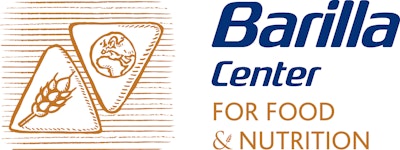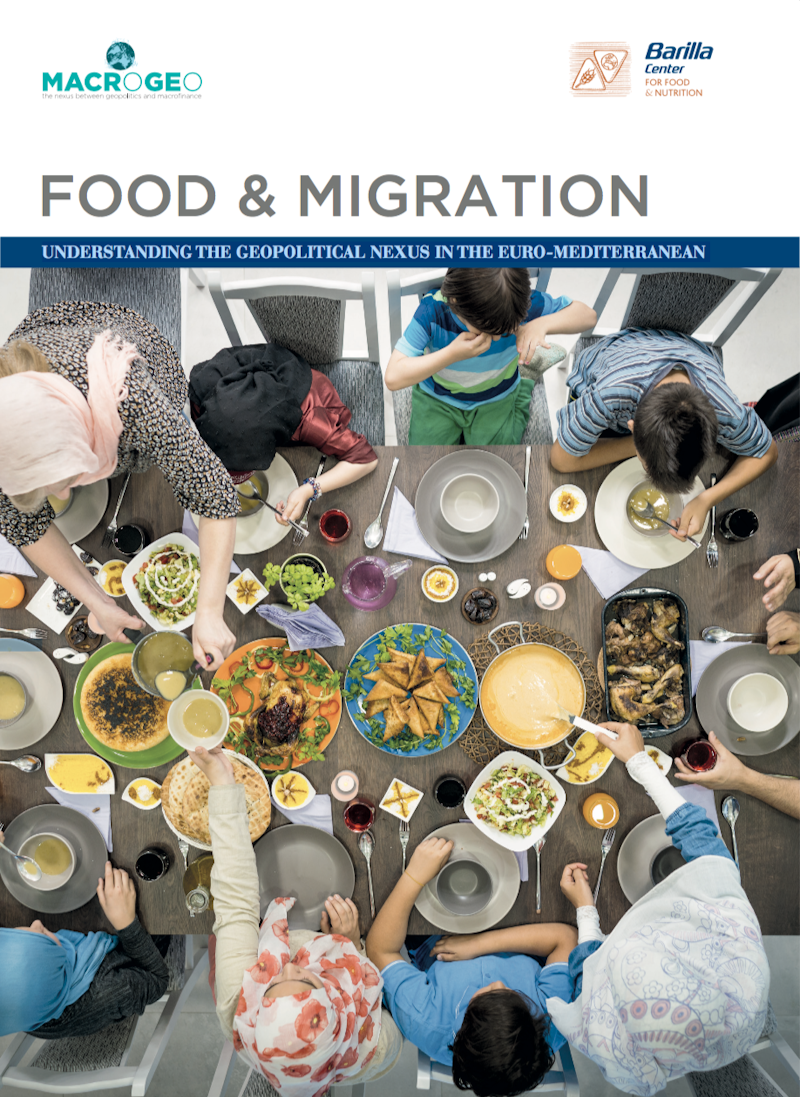Climate Change and Human Migrations
by Monia Santini, Luca Caporaso, Giuliana Barbato, Sergio Noce
Foundation Euro-Mediterranean Center on Climate Change (CMCC)
Climate change is an important factor in assessing the past, present and future vulnerability of countries of origin, transit and destination of migrants. Over the long term, climate modifications across the Trans-Mediterranean region appear stronger than general global trends. In the future, in the Trans-Mediterranean region climate change and variability could lead to a warming around 0.7°C within the next couple of decades, which will more than double by 2050.
Introduction
In the wake of the latest reports published by the Intergovernmental Panel on Climate Change (IPCC 2012; 2014), many initiatives and projects attempted to quantify the current to future vulnerability under climate change for the different countries and regions of the world.
As noteworthy example, the Notre Dame-Global Adaptation Index (ND-GAIN, http://www.nd-gain.org) uses 45 core indicators to measure vulnerability and readiness for more than 180 United Nations countries from 1995 to the present, considering sectors like water, food, health, human habitats, infrastructures, ecosystem services. Vulnerability is intended as combination of exposure, sensitivity and adaptive capacity 1, while readiness regards social, governance and economic ability to leverage investments towards adaptation actions2. Similarly, the joint World Food Programme and MetOffice initiative “Food Insecurity & Climate Change” (http://www.metoffice.gov.uk/food-insecurity-index/) focused on Least Developed and Developing Countries to investigate their vulnerability to suffer from climate change impacts in terms of food security, under current conditions and in the future. Based on the Hunger and Climate Vulnerability Index (HCVI) from Krishnamurthy et al. (2014), vulnerability was again calculated as combination of exposure, sensitivity and adaptive capacity.
Food security is dependent on climate through impacts on water resources and agricultural production. Meteorological droughts (lack of rain) often lead to hydrological and agricultural droughts (lack of water in surface to underground water bodies, and of moisture in the soil), so that the fulfilment of crop water requirement is at risk from both the rainfed and irrigation side (Ronco et al. 2017). Moreover, climate variability accounts for up to 60% of yield variability in major parts of the world (Ray et al. 2015) and is thus a crucial factor for food stability. Vulnerability to climate change of water and food security is recognized influencing migration of individuals and communities from the most vulnerable to the less vulnerable areas as an opportunity to adapt (Grecequet et al. 2017). At the 21st Conference of Parties (COP21) of the United Nations Framework Convention on Climate Change (UNFCCC), a task force was established to develop recommendations on “integrated approaches to avert, minimize and address displacement related to the adverse impacts of climate change”. In general, migrations related to slow-onset climate-related events, such as droughts and land degradation, are more lasting than migrations caused by fast-onset events, such as floods, storms, tsunamis or fires. This is even more true where the high vulnerability to climate change coincides with other drivers, such as conflicts, ethnic polarization, weak political structures and low levels of economic development (Brzoska, Fröhlich 2015). Conflicts especially can be both a direct driver and a consequence of climate-related migrations because of resources scarcity (Hsiang et al. 2013).
Due to the complexity and spatial heterogeneity of the climate-migration-conflicts nexus, and to enable a more comprehensive understanding, it becomes essential to expand our knowledge about the resources’ vulnerability to climate change, potentially affecting displacements and/or conflicts, in all the countries affected by migrations (origin, transit, destination).
To this end, the observed and expected changes in the exposure and sensitivity to climate hazards, as component of vulnerability assessment, has been analysed, looking at trends and extremes of meteorological conditions, agricultural yield and water availability (proxies of food and water security) along the historical and future periods for the Trans-Mediterranean migrations’ region, which recently deserved particular attention due to the spatio-temporal changeability of routes, people involved and issues triggered (institutional divergences, human rights, cultural diversities, social instabilities, employment conducts, health problems).
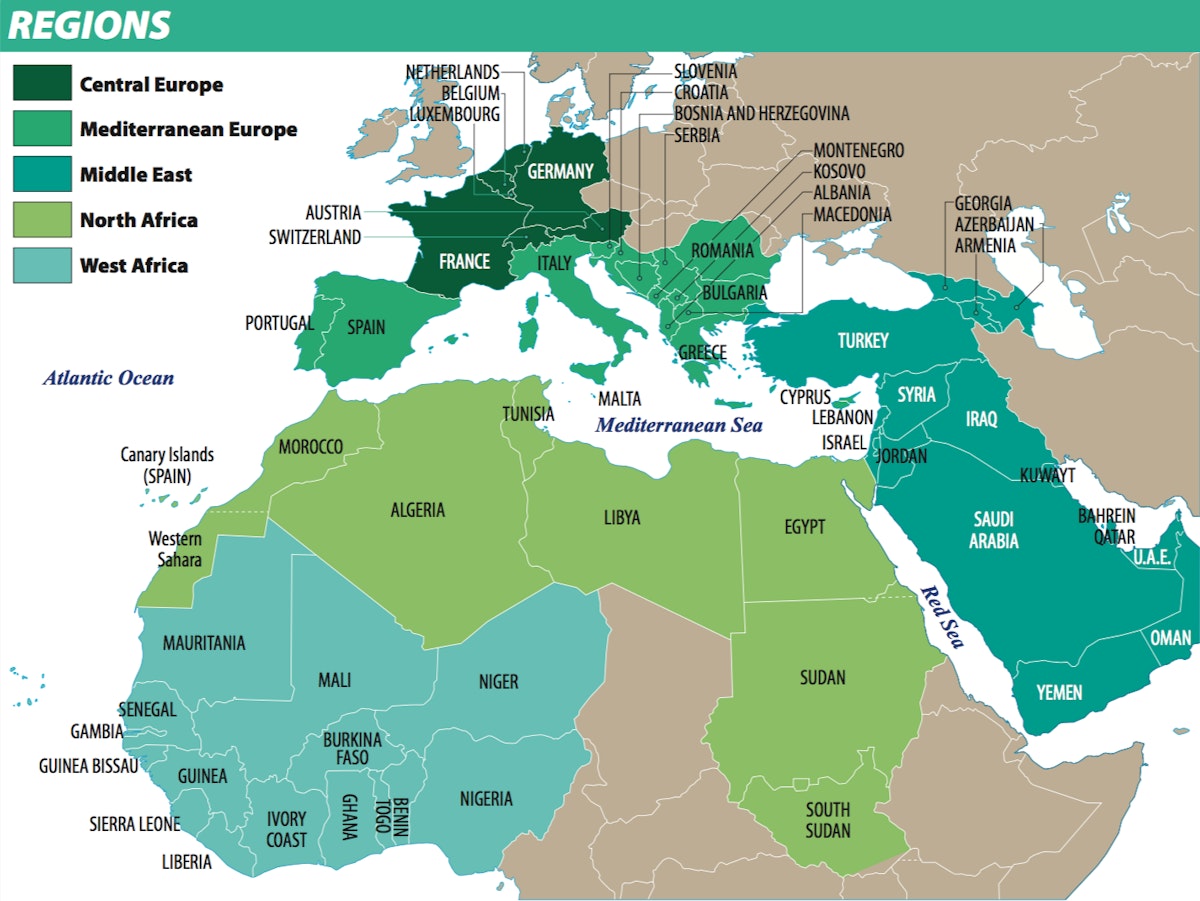
Methods
The spatial domain of our analysis has been set to cover five regions, each comprising several countries, as listed below:
Central Europe: Austria, Belgium, Luxembourg, France, Germany, Netherlands, Switzerland.
Mediterranean Europe: Albania, Bosnia and Herzegovina, Bulgaria, Croatia, Cyprus, Greece, Italy, Kosovo, Macedonia, Malta, Montenegro, Portugal, Romania, Serbia, Slovenia, Spain.
Middle East: Armenia, Azerbaijan, Bahrain, Georgia, Iraq, Israel, Jordan, Kuwait, Lebanon, Oman, Qatar, Saudi Arabia, Syrian Arab Republic, Turkey, United Arab Emirates, Yemen.
North Africa: Algeria, Egypt, Libya, Morocco, South Sudan, Sudan, Tunisia, Western Sahara.
West Africa: Benin, Burkina Faso, Gambia, Ghana, Guinea, Guinea-Bissau, Ivory Coast, Liberia, Mali, Mauritania, Niger, Nigeria, Senegal, Sierra Leone, Togo.
The analysis on the regional level was then focused to the 13 major players reported in bold.
In this chapter, both trends and variability of temperature and precipitation are analysed, including extremes events with focus on meteorological droughts, as they drive long-lasting migrations by affecting:
– water security, here addressed by examining trends on the surface water availability and hydrological droughts’ occurrence.
– food security, here treated by analysing agricultural yield variability for selected key crops, maize, wheat, rice, soybean, which share large part of global cereal and leguminous-oil crop production, cover energy and protein requirements for the human diet, and are largely studied through scientifically sound literature and data also because their importance in the food-feed-bioenergy debate (Di Paola et al. 2017).
To investigate historical trends in climate, as well as in water availability and agricultural production, the most update and reliable datasets have been searched, selected and elaborated: CRU3, CLIMDEX4, SPEIbase5, ERA-Interim6 and FAOSTAT7. The historical period was analysed from the middle of the 20th Century to recent years, and adjusted in function of the temporal coverage of data. Two shorter periods of 20-years, indicatively 1971-1990 and 1995-2014, were then analysed and compared.
Then, future trends were investigated by elaborating climate and impact model-based simulations belonging to the ISI-MIP coordinated initiative8, selecting experiments and data under two representative concentration pathways (RCPs) for greenhouse gases (proxy of emission scenarios), assumed having medium to high impact on climate9, and under different anthropogenic influence (i.e. irrigated or not irrigated agriculture, with or without human impact on water resources). The reference year of the future analysis was 2005, representative of the 20-year period 1996-2015, to which comparing two future time-frames to evaluate the impact of climate change: 2016-2035 (short term or near future) and 2041-2060 (medium term or far future).
Results
Historical analysis
Concerning the observed period, the climate modifications occurred across the Trans-Mediterranean region appear stronger than for the globe. The warming of +1.4°C (corresponding to trends of +0.02°C per year on average) seem spatially homogeneous along the latest 65 years (1951-2015). Such trends were more marked during 1971-1990 (+0.04°C per year), especially across the Iberian Peninsula and the north-west of African domain, and during 1995-2014 (+0.03°C per year) especially in the easternmost part of the domain (Eastern Europe, Egypt and Sudan).
Still from 1951 to 2015, the annual rainfall was reduced on average for about 36 mm (0.55 mm per year) in the domain, reaching decreases larger than 160 mm (2.5 mm per year) for some countries in West Africa. The period drying faster was 1971-1990, affecting especially European Mediterranean countries and West Africa. Besides trends of decreasing annual rainfall, droughts became more frequent, intense and prolonged, with the maximum length of consecutive days without rainfall increasing by 13 days (i.e. by 1 day every 4-5 years).
Trends and variability of precipitation are well reflected in the hydrological balance, showing how the study region faced a decrease of water availability (each year from 1979-2015, 2 mm less of surface runoff were generated) opposite than the global increase (+0.6 mm per year). Such a land drying was more marked in Sub-Saharan African countries, Central-Eastern Europe and Caucasus.
Results concerning agricultural production show a consistent yield increase along the last five-six decades for the key crops analysed, likely associated to technological development, except for wheat in Nigeria, maize in Morocco and soybean in Mali, that are among the major players of migrations. Nevertheless, a loss of increasing trends and/or of trends’ statistical significance is found if considering shorter time frames (20 years) and especially the most recent decades 1995-2014, suggesting a rising impact from climate variability, esp. in Africa and Central Europe for wheat, in Africa for maize, and Sub-Saharan Africa for rice and soybean. Peaks of negative yields’ anomalies, ranging from -20 to -60%, match with drought episodes, especially from 2005 to 2007 for Spain, from 1997 to 2003 for Italy, in 1976 and 2003 for France and Germany and around 2007 for Turkey. The same matching between drought and yield drop is evinced for Morocco in 1994-1995, 2001 and 2006-2007, for Algeria and Egypt in 1983-1984, and to a lesser extent still for Algeria during 1972-1973. Extended droughts in 1972-1973, 1983-1984 and 1991-1992 also affected West Africa countries in maize, rice and soybean production.
Future analysis
Although the observed general yield increases because of technological development, yields are not improving fast enough to keep up with projected demands in 2050 for food, feed and energy. Moreover, a reasonable development of the agricultural sector, besides being sustainable through maintenance of ecosystem services and climate mitigation, should be adapted and resilient to further expected changes in climate and resources’ availability, so to reduce likely drops in crop yield due to new uncomfortable conditions (loss of land suitability) for cultivations.
Looking at climate projections, the expected conditions across the Trans-Mediterranean region suggest a spatially homogeneous warming, slightly weaker than for the globe, even if such differences will reduce in the medium term and under the worst emission scenario. More in detail, a substantial warming (from +0.61 to +0.77°C, according to the different emission scenarios considered) might affect the region in the shorter term 2016-2035 period compared to the reference period 1996-2015. The temperature anomaly is predicted to increase homogeneously (+1.44/+2.14°C) in the second period considered (2041-2060) with a warming peak in the Middle East sub-region under the worst emission scenario (+2.32°C). The warming, as averaged across emission scenarios, is shown in the warming maps in the following pages.
The maps represent the temperature anomaly for the Trans-Mediterranean sub-regions in the near-term future 2025 (representative of 2016-2035) and the medium-term future 2050 (representative of 2041-2060), in both cases with respect to 2005 (representative of 1996-2015). The anomaly is averaged across different emission scenarios.
For that concerning annual rainfall at global level, it is predicted to increase by ~1% (~9 mm) in the near future (2016-2035) and by ~4% (~30 mm) in the far future (2041-2060) while a weaker increasing up to a decreasing tendency (ranging from +0.5% to -1.4%) is predicted in the Trans-Mediterranean region according to the different emission scenarios and periods considered. At sub-regional level a dual behaviour is observed: a drying trend is predicted to affect all the considered domain except West Africa. In particular, the Mediterranean Europe and the Middle East are expected to experience the strongest rainfall decrease (-7.1% equal to -57 mm and -7.4% corresponding to -18 mm, respectively) according to the worst scenario for the period 2041-2060. In contrast, the annual precipitation over West Africa is predicted to increase for about 1.5/2.4% (equal to a rainfall gain of ~10/16 mm) in the near future and the wetting tendency is confirmed when analysing the far future with a rainfall gain of ~ 4.5/5.7%. The general drying, as averaged across emission scenarios, is shown in the drying maps in the following pages.
The drying maps represent the rainfall anomaly for the Trans-Mediterranean sub-regions in the near-term future 2025 (representative of 2016-2035) and the medium-term future 2050 (representative of 2041-2060), in both cases with respect to 2005 (representative of 1996-2015). The anomaly is averaged across different emission scenarios.
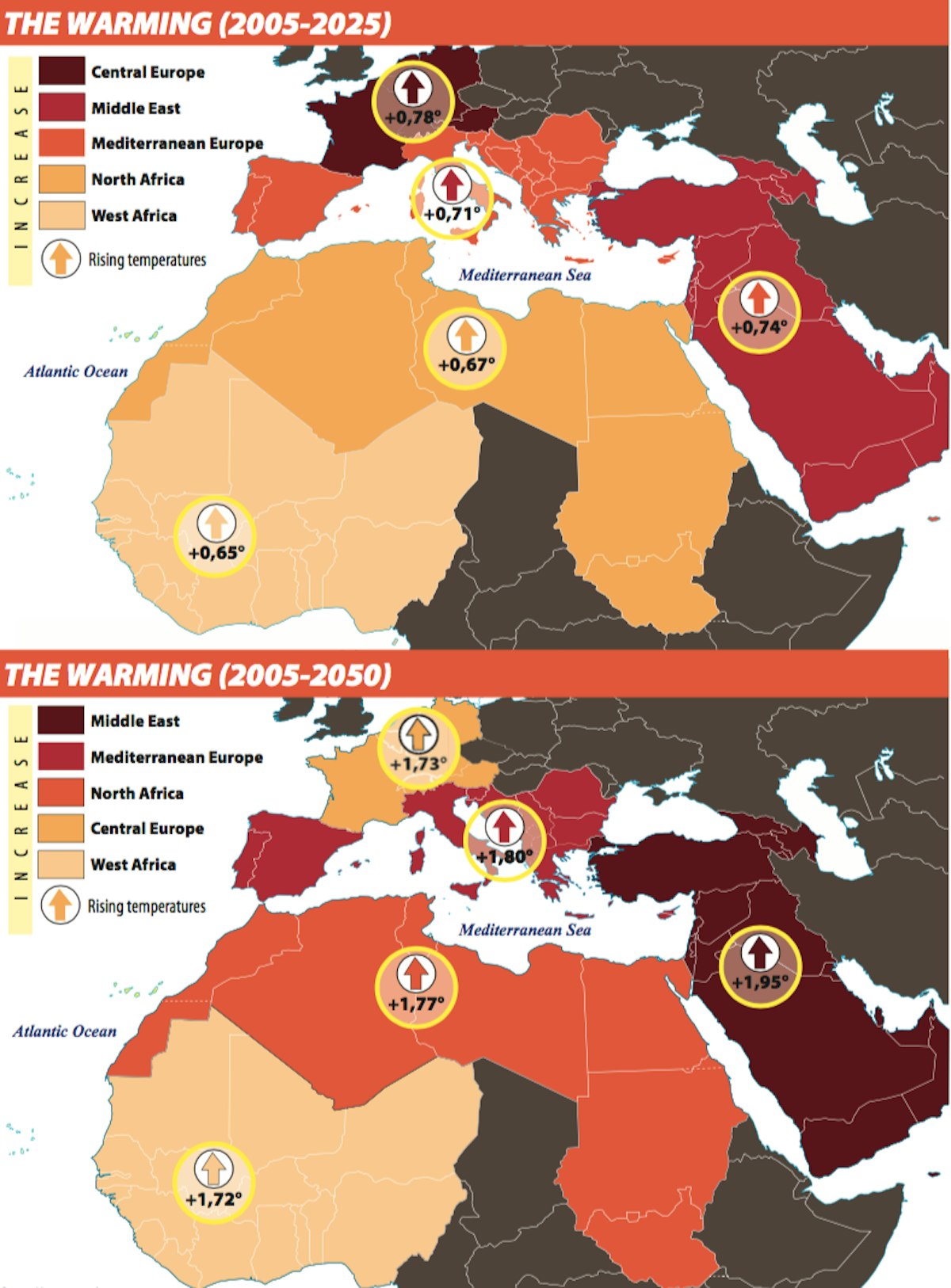
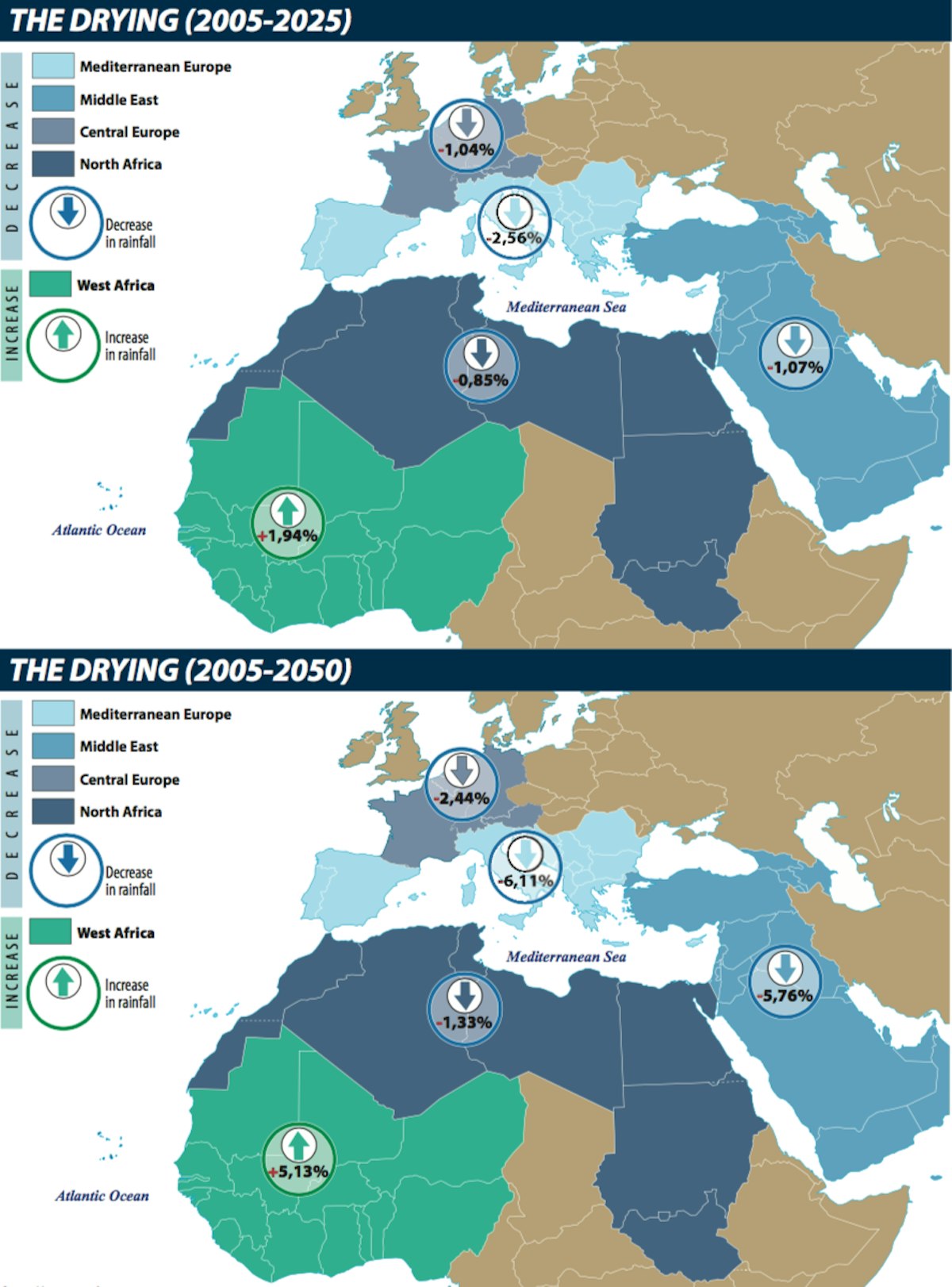
Moderate to severe drought episodes for 3-month periods are expected to increase in frequency across the Trans-Mediterranean region, with respect to the historical period, by two to almost five times, while for the globe the increase is lower and between two and three times. In particular Mediterranean Europe, followed by Central Europe and Middle East, will experience the strongest increase in drought frequency, around six/seven times more than the historical period. Results in case of long lasting drought (six months) reveal Mediterranean Europe and Middle East as the most affected regions, with frequency from two to four times higher than in the historical period.
Due to the general trends and variability in rainfall, the study region will face a general decrease of water availability. The Trans-Mediterranean region is expected to dry, from 2 to 7% in terms of drop in runoff generation. Such a land drying is more marked in the Mediterranean Europe, Middle East and North Africa with a mean decrease of about 16% in 2041-2060 (ranging from 14 to 19%), confirming how increasing drops in rainfall lead to even more higher, not-linear, drops in runoff. The general land surface drying, as averaged across emission scenarios, is shown in the drying maps.
The maps Change in water runoff in the next page represent the runoff generation anomaly for the Trans-Mediterranean sub-regions in the near-term future 2025 (representative of 2016-2035) and the medium-term future 2050 (representative of 2041-2060), in both cases with respect to 2005 (representative of 1996-2015). The anomaly is averaged across different scenarios of emissions and of human impacts on water.
Concerning future agricultural production, at global level a yield increase is expected, likely associated to the dominance of technological development, for maize (~2/3% up to ~6/7% in the near and far future, respectively), no significant trends are found for both rice and soy, while a decrease is expected in wheat production, ranging from -1/-1.5% in the near future to -3/-5.5% in the far future either considering or not the use of irrigation.
In contrast to the global trends, the regional scenarios of maize yield show a clear decrease (from -1/-2% in the near future to -3/-8% in the far future). The strongest decrease is expected to occur in West Africa, one of the major player for maize production, regardless if using or not irrigation (yield drop reaches -10/-15% in the far future scenario). The other two main players for maize production, Central and Mediterranean Europe, suggest that losses of yield (up to -3% to -7%, respectively, in the worst far future scenario), can be avoided only if irrigation is applied, thus increasing competition over diminishing water resources.
In case of wheat, the near future scenarios suggest a small decrease both at global and regional level (no higher than 5% for the Trans-Mediterranean region) while the decrease gets stronger when considering the far future (13%) driven by losses in Africa (especially West, with drops up to 26%) and Middle East.
The rice yield is expected having no significant change in the near future, and a moderate decrease in the far future, while significant increases are expected in the far future if looking at sub-regional level: Central Europe and the Mediterranean should increase the yield for about more than 43% and 12%, respectively, under irrigation (the lesser yields in case of no irrigation have slightly lower increase), West Africa will experience the most pronounced decrease (up to 15%).
Soybean cultivation, key also for climate mitigation strategies due to the production of biofuels, seem experiencing pronounced decrease of yield in all the Trans-Mediterranean domain (up to -20% in the worst scenario for West Africa) while a significant increase is predicted for the Central Europe, higher when irrigating, and for Mediterranean Europe, but only in case of using irrigation. Again, this suggests the growing key role of water to maintain agricultural production.
The changes in crop yields, as averaged across emission and irrigation scenarios, are shown in the summary below.

It represents the crop yield anomaly for the Trans-Mediterranean sub-regions in the near-term future 2025 (representative of 2016-2035) and the medium-term future 2050 (representative of 2041-2060), in both cases with respect to 2005 (representative of 1996-2015). The anomaly is averaged across different scenarios of emissions and of irrigation applications.
Conclusions
Along the last six decades, in the Trans-Mediterranean region climate change and variability led to a warming of 1.4°C and to a rainfall reduction of 36 mm, while the decrease in surface water availability was up to four time higher than the decrease in rainfall. Extreme drought episodes also became more severe and recurrent, frequently matching with years of negative yield anomalies (up to -60%) for maize, wheat, rice and soybean.
For the future period, in the Trans-Mediterranean region climate change and variability can lead to a warming of ~0.7°C within the next couple of decades, which will more than double at the middle of the Century. Drop in runoff will be from 5 to 10 times stronger than drop in rainfall in function of the time horizon considered (short- or medium-term future, respectively). Drought episodes will become more frequent, at least doubling the historical occurrence. In case of both rainfed and irrigated agriculture, the yields for the key energy and protein crops considered are at strong risk due to the combination of new climate and water resources regimes, with the increase in irrigation needs posing additional challenges to the share of water resources among sectors and adjacent countries in the regions.
Key messages are that it is not only the area of origin of Trans-Mediterranean migrations (African countries and Middle East) that will be increasingly affected by climate change hazards impacting water and food systems, but also European countries. This constitutes not only a risk but also an opportunity for food production, as the modified climate conditions have the potential to increase suitability for new or currently minor cultivations in the north of the Mediterranean basin, while the southern side will lose productivity for all crops analysed if not adapting to climate change.
Notes
1 Exposure: The extent to which human society and its supporting sectors are stressed by the future changing climate conditions. Exposure captures the physical factors external to the system that contribute to vulnerability.
Sensitivity: The degree to which people and the sectors they depend upon are affected by climate related perturbations. The factors increasing sensitivity include the degree of dependency on sectors that are climate-sensitive and proportion of populations sensitive to climate hazard due to factors such as topography and demography.
Adaptive capacity: The ability of society and its supporting sectors to adjust to reduce potential damage and to respond to the negative consequences of climate events. Adaptive capacity indicators seek to capture a collection of means, readily deployable to deal with sector-specific climate change impacts.
2 Economic Readiness: The investment capability that facilitates mobilizing capitals from private sector.
Governance Readiness: The stability of the society and institutional arrangements that contribute to the investment risks. In a stable country with high governance capacity investors are assured that the invested capitals could grow under the help of responsive public services and without significant interruption.
Social readiness: Social conditions that help society to make efficient and equitable use of investment and yield more benefit from the investment.
3 Climate Research Unit; https://crudata.uea.ac.uk/cru/data/hrg/
4 CLIMDEX – Datasets for Indices of Climate Extremes; http://www.climdex.org/
5 Global SEI database; http://spei.csic.es/database.html
6 ERA-Interim Reanalyses; https://www.ecmwf.int/en/forecasts/datasets/reanalysis-datasets/era-interim
7 FAOSTAT – Food and Agriculture data; http://www.fao.org/faostat/en/#home
8 Inter-sectoral Impact Model Intercomparison Project (ISI-MIP); https://www.isimip.org/about/
9 RCP4.5 considers that radiative forcing is stabilised shortly after year 2100, consistent with a future with relatively ambitious emissions reductions. RCP8.5 is characterised by increasing greenhouse gas emissions that lead to high greenhouse gas concentrations over time.
